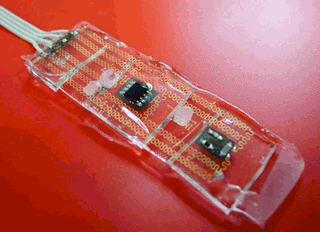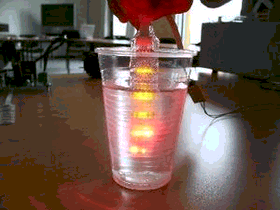July 10, 2007 feature
Elastic circuit connectors designed for rubber-band-like circuits

Researchers from Belgium have devised a plan for making headway into the area of flexible, washable electronics. These integrated electronics, which could be incorporated into clothing and biomedical applications, require all connections between components to stretch like rubber bands while maintaining their conductivity.
The researchers, Dominique Brosteaux, Fabrice Axisa, Eva De Leersnyder, Frederick Bossuyt, Mario Gonzalez, and Jan Vanfleteren, of the Interuniversity Microelectronics Centre and Ghent University in Belgium, have recently designed and fabricated elastic interconnections that can stretch to more than twice their original lengths (a 100% stretchability). Their results are published in a recent issue of IEEE Electron Device Letters.

“For biomedical and textile applications, the comfort of the user will be enhanced if the electronic circuits are not only flexible, but also elastic,” the researchers explained in their study. “Biomedical applications include implantable devices and electronics on skin.”
In the paper, the scientists describe how they constructed 3-cm-long elastic connectors by embedding 4-micrometer-thick gold wires in a highly elastic silicone film. The wires were coated with a 2-micrometer-thick nickel layer for soldering wires to the ends.
“Besides this construction, our team has also been developing alternative versions of this technology based on the same molded interconnect device (MID) technology,” Vanfleteren told PhysOrg.com. MID can combine electrical and mechanical functions on a single unit, replacing the conventional circuit board.
The group patterned the gold wires onto a substrate in a “horseshoe”-shaped form, which significantly reduced the stress compared with an elliptical shape, while maintaining the initial electric resistance. The horseshoe shapes were then connected to create a wave-like pattern. To further increase the elasticity, the researchers found that splitting the wire conductor track into four thinner (15-micrometer-wide) tracks greatly minimized the induced stress.
The researchers then tested a variety of different shaped connectors by stretching them to the point of electrical failure, which is caused by a rupture in the metallic track. The best connector stretched from 3 to 6 centimeters without losing conductance. However, all interconnections—even those that experienced electrical failure—recovered their conductance when they returned to their normal length.
Currently the group is developing technology toward the incorporation of the elastic interconnections into full electronic circuits. This goal is being pursued by three projects: BioFlex (Biocompatible Flexible Electronic Circuits) with funding by the Institute for the Promotion of Innovation by Science and Technology in Flanders; STELLA (Stretchable Electronics for Large Area Applications) with funding by the European Commission; and SWEET (Stretchable and Washable Electronics for Embedding in Textiles) with funding by the Belgian Science Policy.
“At the moment we’re focusing on the following applications: implantable electronics, smart textiles (with integrated stretchable circuits), and smart band aids (e.g. measuring physiological parameters that should follow skin deformations),” Vanfleteren said, adding that further details remain confidential at this time.
The latest developments of the group on stretchable circuits can be found on their Web page:
tfcg.elis.ugent.be/projects/stretchable.html
Citation: Brosteaux, Dominique, Axisa, Fabrice, Gonzalez, Mario, Vanfleteren, Jan. “Design and Fabrication of Elastic Interconnections for Stretchable Electronic Circuits.” IEEE Electron Device Letters, Vol. 28, No. 7, July 2007.
Copyright 2007 PhysOrg.com.
All rights reserved. This material may not be published, broadcast, rewritten or redistributed in whole or part without the express written permission of PhysOrg.com.





















